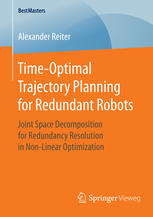

Most ebook files are in PDF format, so you can easily read them using various software such as Foxit Reader or directly on the Google Chrome browser.
Some ebook files are released by publishers in other formats such as .awz, .mobi, .epub, .fb2, etc. You may need to install specific software to read these formats on mobile/PC, such as Calibre.
Please read the tutorial at this link: https://ebookbell.com/faq
We offer FREE conversion to the popular formats you request; however, this may take some time. Therefore, right after payment, please email us, and we will try to provide the service as quickly as possible.
For some exceptional file formats or broken links (if any), please refrain from opening any disputes. Instead, email us first, and we will try to assist within a maximum of 6 hours.
EbookBell Team

4.0
96 reviewsThis master’s thesis presents a novel approach to finding trajectories with minimal end time for kinematically redundant manipulators. Emphasis is given to a general applicability of the developed method to industrial tasks such as gluing or welding. Minimum-time trajectories may yield economic advantages as a shorter trajectory duration results in a lower task cycle time. Whereas kinematically redundant manipulators possess increased dexterity, compared to conventional non-redundant manipulators, their inverse kinematics is not unique and requires further treatment. In this work a joint space decomposition approach is introduced that takes advantage of the closed form inverse kinematics solution of non-redundant robots. Kinematic redundancy can be fully exploited to achieve minimum-time trajectories for prescribed end-effector paths.